Cossacks: European Wars Preview
Does this game have any unique qualities, or is it just another Age of Empires II clone?
It seems gamers are beginning to appreciate history, or at least developers think they are. Wargames and classic strategy fare like Civilization have always been based on history, but it wasn't until Age of Empires and Age of Kings that history again became interesting for gamers. Age marked a departure from sci-fi or fantasy gaming, and it appears that several developers are following in Ensemble's footsteps. European Wars: Cossacks is one such game, and it comes from German developer CDV. Scheduled to be released in March 2001, it brings Age of Empires II-style gameplay to Renaissance Europe.
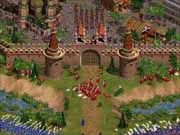
Cossacks is a new real-time strategy game that fans of Age of Empires II will find instantly familiar. In fact, after only a few minutes with this game, you will swear it plays almost exactly like Ensemble's Age II. Were it not for the fact that the game focuses on Europe instead of the world, there might even be a few fans crying plagiarism. Actually, because of Cossacks' similarity to Age II, we had no problem learning the basics of gameplay through trial and error, even without a manual. This bodes well for the game's ability to quickly rope in gamers, as having to learn a new set of controls would simply bog down gameplay. Like Age II, Cossacks uses a right-click interface - it even has a similar array of units. However, beyond the familiar look and feel, there is definitely enough here that is new and different to warrant a closer look.
The setting for Cossacks is an unusual one, and we won't know until the game ships whether American gamers will respond to a real-time strategy game based on the tumultuous and war-torn 17th and 18th centuries in Europe. You can choose from more than a dozen different "factions," which are actually states or nations from that time period. There are familiar nations, such as England, France, Turkey, and some new nations, which have not appeared in real-time strategy games until now. Some of the other nations you can play are Austria, the Netherlands, Portugal, Prussia, Russia, Spain, Sweden, Ukraine, Algeria, and a few others. Gameplay is generally the same regardless of the nation you play, although some nations do have slightly different units and upgrades, as well as units with different names.

Cossacks has the usual suite of gameplay options. You can play a single-player game and choose among campaigns, historical battles, or single random map games. You can also play mulitplayer games over Internet or LAN and play either random map games or replay historical battles. You can customize random map games in both single and multiplay with different variables, such as landscape type, the nature of the ground, initial level of resources, and the richness of minerals. The landscape type varies the amount of land vs. water on the map, while the nature of the ground varies the elevation, like plains or mountains.
First Impressions
Unlike the time period in Age II, the time period of this game is much more compressed and advanced. The setting is basically 17th- and 18th-century Europe, so there are a lot of gunpowder units. Surprisingly, the naval game doesn't seem as fleshed out as the land-based combat. There are only a handful of water units, which include ferries and fishing boats. The military ships consist of the galley, frigate, and the battleship. So it seems that this game's naval combat doesn't have the complexity of Age II's ship-to-ship combats or Starcraft's air-to-air battles. However, naval battles are still quite spectacular, and they are more slugfests than chess matches. It's just a matter of lining up more and better-upgraded ships against the enemy's line and slugging it out, trading cannon shot for cannon shot.
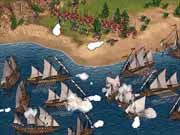
However, Cossacks boasts numerous land units that do combine for quite strategic gameplay. As in Age II, there are lots of counters and special designs to each unit. Almost all units are specially designed for one particular task, and while they do that one task well, they are woefully inadequate in other tasks and are also highly vulnerable to counterunits.
Even though the game is 2D, it looks clean and crisp. The water and coastlines are made up of sparkling water and rippling waves, which actually look good. Although the graphics aren't as sophisticated as those in games like Ground Control, they are good enough to provide colorful and functional visuals. The units are also differentiated, so it is easy to tell at a glance which unit is a janissary (he wears a white dress and a tall hat) or an infantryman (he wears a vest and wields a scimitar). However, the animation for the units isn't as smooth as the animation in Age II. Some units and buildings do have nice detail, and some of the naval explosions and battles look particularly nice. Sometimes you'll see a ship explode and hurl a shower of wood and debris into the water, creating dozens of tiny splashes.
There are different looks to the different nations so that Austrian buildings are more Western European in appearance while the Turkish buildings look more Middle Eastern. Austrians, for example, will construct cathedrals, whereas the Turks will build mosques. However, these differences are pretty much cosmetic.
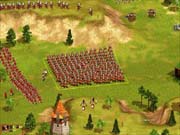
The AI seems fairly good - or it at least knows to amass a huge force before attacking and also knows to attack where you aren't defending. Numerous times while battling the enemy AI, we saw the AI's troops speed past our towers straight for the important strategic targets, such as the town center, store houses, and mills. It attacked our production areas, as any good player would do in an RTS battle in which resources were key.
Something else we noticed while playing the game was that the pace seemed much faster in than normal real-time strategy games. This mostly comes from the accelerated unit creation. The low-level units come out of their buildings especially quick. If you set up a rally point far away from your barracks, for example, rather than seeing a trickle of units marching over to the rally area, you'll see a stream of them. These units are basically being churned out one by one. Armies can be accumulated quickly in this game, without the long wait you experience in other real-time strategy games. There are, of course, units that take longer to build relative to the early units, especially the heavy cavalry and gunpowder units, but, in general, all units are created faster than what you're typically used to. The pace of the game just seems to be noticeably faster in Cossacks, and it appears to be by design.
Resources
Aside from the quickness of unit production, there are other areas in which Cossacks differs from its competition. The resource system is one such area.
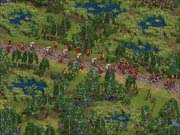
There are six resources to manage in Cossacks: wood, stone, food, iron, gold, and coal. Wood and stone are harvested the same way as in Age of Empires II: You lay down a building near the resource, you deposit them in storehouses, and then you tell your villagers to start chopping or mining. Then they bring the wood and stone back to the storehouse. Food handles a little bit differently. You first lay down a mill, but you don't build any farms. Instead, on the mill interface, you can click is a simple single button, which plants grains in a circle around the mill. Over the course of a minute, you'll see the fields start to grow with grain. After the squares around the mill are full of tall wheat, they are ready to be harvested. You then right-click onto the wheat squares around the mill and the villagers go in, harvest the grain, and dump it off in the centrally located mill. It's a lot more efficient and intuitive than the farming in Age II. And, unlike in Age, you'll see that whenever the fields start to become depleted, it'll happen long before they disappear. There is a visual indicator as the fields begin to thin - at this point, you can just go back to the mill and click the seed button, which replants the fields.
The real difference in resources, though, comes in the form of gold, coal, and iron. These three "minerals" are very important to the high-level units in the game, such as gunpowder units and heavy, armored cavalry. Many advanced technologies are also fueled by these resources. However, to harvest them isn't as easy as building a mill and planting grains or building a storehouse near forests or rocks. You need to look for pockmarks on the ground, fissures that at first looked innocuous and more like cosmetic features than actual interactive elements on the map. When you see these fissures, they come in three varieties. By scrutinizing the insides of the fissures, you'll see either yellow or black within. It's hard to differentiate these fissures, but they're actually veins of minerals on top of which you must build a mine. Depending on the kind of mineral vein upon which you've built the mine, you'll get an iron, coal, or gold mine. Then you need to send in up to five villagers, who stay permanently inside. As soon as that starts happening, you'll begin accumulating the respective mineral automatically. The more mines and the more villagers within each mine you have, the faster you'll accumulate. At first, it was very hard to discern these fissures, and even afterward, it was difficult to tell the mineral veins apart. However, the resource model makes sense, and it is vital to playing the game.
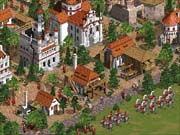
Units actually require constant resource upkeep. So your infantry, pikemen, cavalry, and warships continually siphon away resources. If you run out of food, for example, you'll experience a famine, and your peasants will slowly die, one by one. It makes it imperative to always have a sizable surplus of food, lest you lose your army to famine instead of your enemy. Gunpowder units are even more dependent on resources, as every shot they fire is fueled by iron and coal. If you run out of those resources, your riflemen, mortars, and even battleships will stand idle and will be unable to fire back at the enemy until you gather more resources.
Units
The units in the game will appear eminently familiar. There are the noncombatants, which are the villagers and priests. The villagers perform all the infrastructure tasks, such as building structures, gathering resources, repairing buildings, and such. The priests, who are built at cathedrals or mosques, can heal, although it appears that they do not convert units as they do in Age of Empires II. Instead, they raise the morale of your troops, which makes them fight better when any friendly priests are nearby.
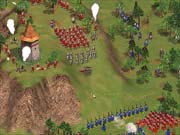
The combatants include several types of units. There are infantry, ranged units, cavalry, and cannons. The infantry and ranged foot units are built at the barracks, and they include pikemen, swordsmen, and riflemen. Different nations have slightly different versions of these units. The nation of Turkey, for example, has Ottoman pikemen, base infantry, and jannissaries, which are its riflemen. The stables building lets you build the cavalry, which consists of speedy light cavalry, heavy cavalry, and cavalry ranged units. The cavalry ranged units include horse archers, like Turkey's bow-shooting Tatars or the rifle-wielding Dragoons of Austria. The array of cannons is quite impressive. There is the base cannon, as well as more potent versions of the gunpowder siege weapon, such as the howitzer, mortar, and multibarreled cannon, which looks like a porcupine of rifles on wheels.
There is a clear hierarchy of power, as well as a need to use combined arms. Pikemen, of course, slaughter cavalry units, and it appears that they slaughter even more so in this game than they do in Age II. The cavalry, in contrast, is superb against regular infantry. The infantry fares well against ranged units once they close with them, as all the ranged units, whether archers or riflemen, have a minimum range. This means if the enemies get too close, they'll stop firing and start backing up to put some distance between themselves and the target before they resume firing. Some units, like the grenadier, are multipurpose units. The grenadier, for example, fires a musket, has a bayonet, and also lobs grenades. This means he can shoot at a distance, defend himself against melee units, and also hurl explosives at buildings, which are otherwise too sturdy for normal infantry or ranged units to take down without exhaustive effort.
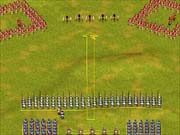
The designers, it appears, are trying to make formations a very big part of combat. The description for many infantry units states that they aren't effective unless they fight in formation, and the enemy AI almost always sends its troops marching in formation. It was difficult with the interface currently in the game for us to specify a formation, but as we played through more of the game, we discovered that perhaps this is by design. There are actually different units - high on the tech tree - that are command units. These are like the drummer and officer. The drummer is needed in order for you to form ranks for your infantry. The officer is then required to give commands to your units in formation. Ostensibly, there are combat bonuses that are conferred upon units in formation and that are being rallied by a drummer and commanded by an officer. Throw in a priest, who improves morale, and you have a more efficient and deadly fighting force. You can even change your tactics, for example, by choosing to stand ground and, therefore, gaining even greater combat bonuses. In theory, it sounds interesting, and it makes formations and officers an important part of gameplay. We tested it out and found that pikemen in formation who stand their ground become almost impenetrable. This should definitely give gamers pause when resorting to the usual build and swarm tactics of other real-time strategy games.
Final Thoughts
Cossacks offers few more wrinkles in the traditional real-time strategy gameplay aside from the formations and constant unit upkeep. Capturing buildings and units should be a prominent part of gameplay strategy when you play the game. You can capture enemy buildings, peasants, and artillery by simply moving one of your cavalry or infantry next to the enemy object. If there is no enemy cavalry or infantry nearby, you automatically capture the unit or building. This prospect of losing your noncombatants or artillery to the enemy requires that you always account for all your peasants and protect every part of your base. If you build defenses on only one side of your base, and if the enemy soaks up some fire while quickly marching through your frontlines to your unguarded flank, you could find your entire town converted by your savvy opponent. This strategy definitely adds a new element to gameplay.
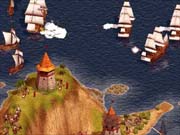
Cossacks seems like a big game. Age of Empires II almost fell into the trap of offering too many choices and too much gameplay. The array of options - in the civilizations to choose, units to build, technologies to research, and tactics to deploy - was too much for quite a few gamers. Cossacks seems to be moving even further in this direction than Age of Empires II did, but with more nations and bigger battles.
The setting is definitely new for the American gamer. Perhaps the narrowing of the arena of combat will be good, though, and will focus instead on a very tight and interconnected area as opposed to a wide-open globe. Renaissance Europe was an exciting time and place. The period was rife with conflict and intrigue, failed diplomacy, and well-chronicled warfare, and Cossacks is hoping to use that history to enhance the game. Cossacks should at least add a bit more history to the RTS formula than Age of Empires did, since Ensemble's game was a less literal translation of world history and more a tournament of warring civilizations on random maps. CDV appears to be injecting more history into its game. Whether gamers want more history with their gameplay, though, is debatable.
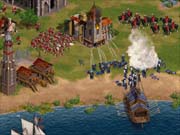
Still, with the twist in resource gathering, as well as the unique setting and emphasis on formations, Cossacks seems as if it's doing a good job of building on the successful formula of Age of Empires II. However, gamers will definitely need to spend a lot of time with the game to get past the initial shock of familiarity - it's so similar at first glance that some will be tempted to ignore it immediately. However, there is enough there to entice those who are interested in taking a second look. Let's hope that between now and the March 2001 ship date, the designers put enough behind the game to make that second look worthwhile.
Got a news tip or want to contact us directly? Email news@gamespot.com
Join the conversation